Acer Predator Helios 300 SpatialLabs Edition Review
Can an experimental 3D screen save this gaming notebook?
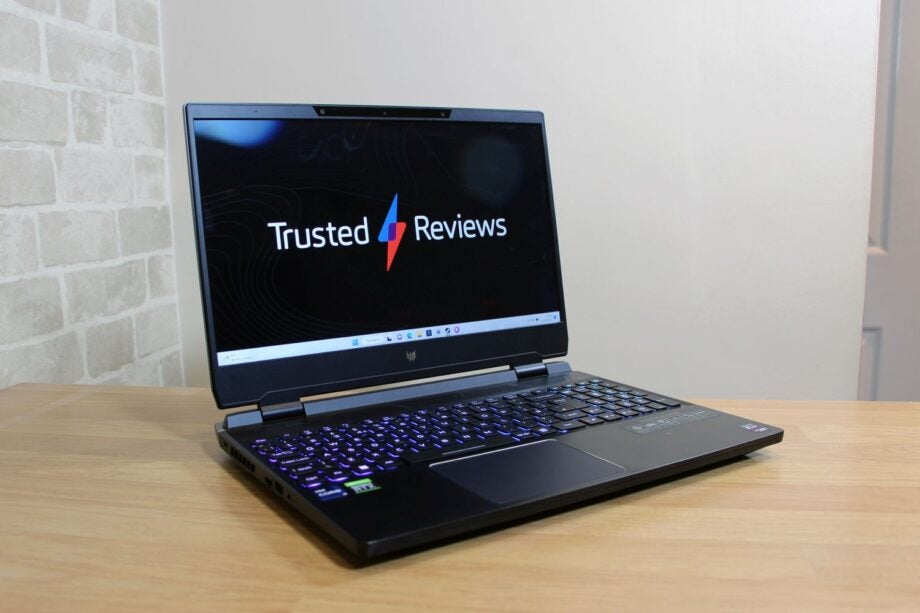
Verdict
The Acer Predator Helios 300 SpatialLabs Edition is ambitious and fast, but its 3D screen doesn’t do enough to be consistently impressive, and it’s underwhelming elsewhere too. So, your money will go further with quicker, more conventional notebooks.
Pros
- Impressive gaming and processing power
- A colourful, high-quality 4K display
- Cool and quiet in default performance mode
- Robust chassis with decent ports
Cons
- Misfiring 3D tech
- Other laptops are faster
- Soft, underwhelming keyboard and trackpad
- Heavy and bulky design
Availability
- UKRRP: £3699
- USARRP: $3498
- EuropeRRP: €3998
Key Features
- An innovative 3D displayIt combines stereoscopic technology, eye-tracking cameras and AI abilities to transform compatible games into 3D titles, so you get more immersion from the 15.6-inch 4K IPS display.
- High-end internals power work and playThe Nvidia GeForce RTX 3080 remains a formidable laptop gaming chip that’ll plough through almost every scenario, and the Intel Core i9-12900H is a content-creation powerhouse.
- Cool, quiet performance and a sturdy designIt’s a robust machine that’ll easily cope with frequent travel, and its effective cooling systems mean it can handle any gaming or work situation without making too much noise.
Introduction
Lots of companies try to innovate in the busy gaming laptop market, but not many do it like Acer – and that remains true of the exciting, surprising Acer Predator Helios 300 SpatialLabs Edition.
Need proof of the innovation on show? Look no further than its 15.6-inch display. The panel deploys 3D technology to make games even more absorbing, and you’ll find top-class Nvidia and Intel internals elsewhere.
But, at $3499 in the US, £3699 in the UK, and nearly €4000 in Europe, there’s no denying that this innovation is expensive. That might make it a more difficult sell, when alternatives like the Alienware x17 R2, MSI Raider GE77 and Asus ROG Flow X16 are ready to pounce should the Predator Helios 300 fall short of the best gaming laptops.
Screen
- The 3D tech has great ambition and impresses when it works – but that’s not often enough
- The underlying 4K display is bold, bright and vibrant and makes games look superb
- The speakers have plenty of volume, bass and midrange quality, so your media sounds immersive
Acer’s SpatialLabs tech is usually found on the company’s ConceptD creative workstation laptops, but you don’t have to use much imagination to see how 3D tech translates to gaming. This notebook combines stereoscopic hardware, a head-tracking webcam and AI to get the job done.
I booted up God of War, and the first impressions were good. The 3D tech delivers a huge boost to the game’s depth. It’s smooth and accurate – even during the fastest and most frantic action sequences – and it undoubtedly improves the gameplay experience.
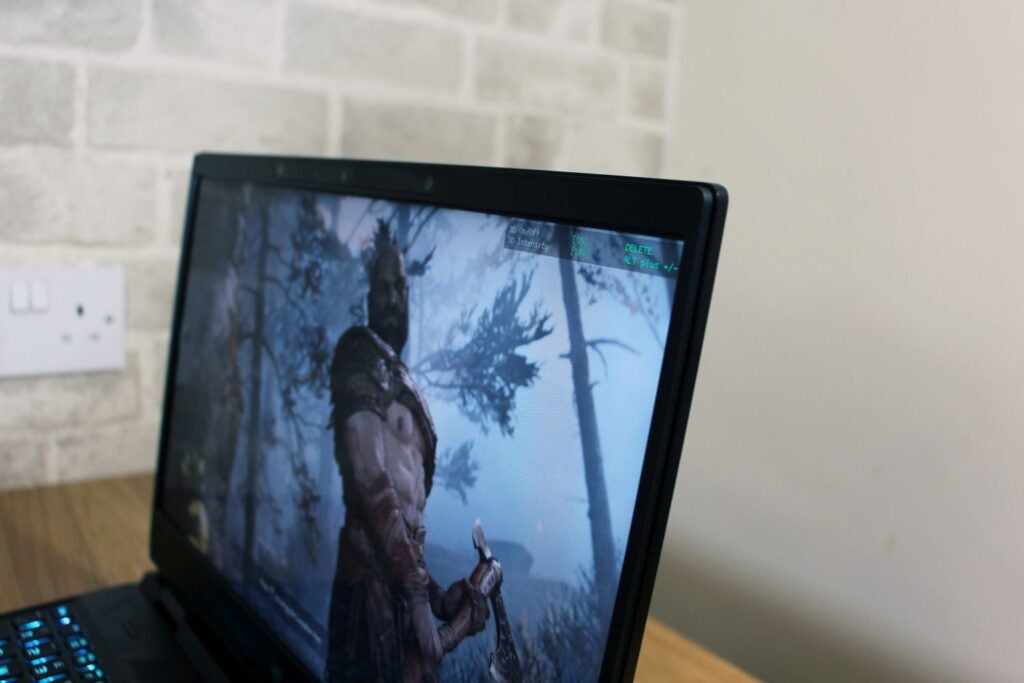
It’s easy to use, too. The SpatialLabs TrueGame app is basically Steam for 3D-compatible titles, and users can adjust the depth of the effect in-game with a keypress. Similarly, straightforward apps add the 3D effect to videos, photos and creative apps.
But the good vibes don’t last. The 3D effect is subtle in Forza Horizon 5, but the game is hindered by obvious tearing and clipping. It would look good if it wasn’t for those bugs. In Shadow of the Tomb Raider, performance is inconsistent, and menus are difficult to use.
You’ve got to keep your head relatively steady to appreciate the 3D effect – alter your viewing angle and immersion is ruined due to the dual renderings jumping around. The 3D hardware also means games are blurrier than on a conventional 4K panel.
Then there’s the game support: while SpatialLabs works with games like Guardians of the Galaxy, Borderlands and the others I’ve mentioned, support for about 50 titles leaves plenty absent. More games may be added and performance might improve, but right now this tech is risky and not consistent enough to be worthwhile.
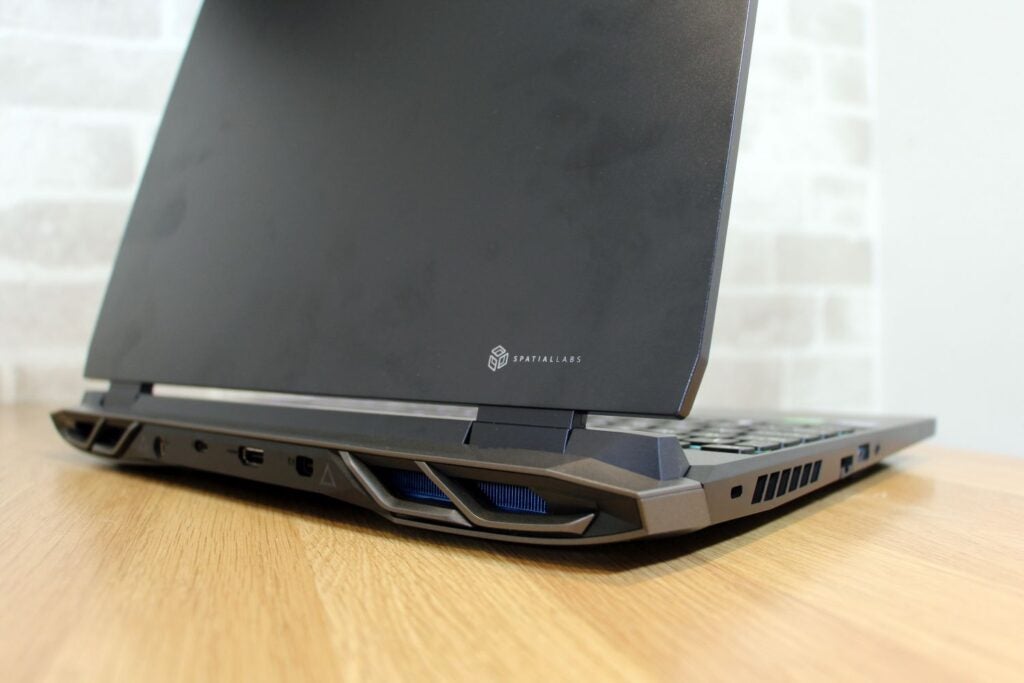
Turn off the 3D tech, and you’ll have a better time with the crisp 4K display. The contrast ratio of 1606:1 is stellar and combines with the black point of 0.17 nits to deliver lashings of low-end depth and top-end vibrancy: games look bright and bold. The 417-nit peak brightness is easily good enough for indoor and outdoor gaming.
The Delta E of 2.62 is accurate enough for gaming, and the display rendered 99.5% and 96.5% of the sRGB and Adobe RGB gamuts with huge volume figures – so colours are brilliant. Combine that with the loud, bold speakers, and you’ve got hardware that’ll make any game look and sound superb.
My only specification quibble is the 60Hz refresh rate. That’s low, and it means this rig is only suitable for single-player games – eSports fans will need an external panel.
Rivals have plenty to say as well, despite their lack of 3D tech. The Alienware is available with 1080p, 1440p and 4K displays at 480Hz, 165Hz and 120Hz. The 17.3-inch MSI combines its 1440p resolution with a 240Hz rate, and the convertible Asus has a bright 16:10 touchscreen at 165Hz.
Design and Keyboard
- Robust, but weighs down your backpack and takes up loads of space
- A good port selection, but you’ll find faster networking and better connectivity elsewhere
- The keyboard and trackpad are too soft to compete with crisp, snappy competitors
Acer’s 3D technology also has an impact outside of the screen: the Predator Helios 300 has large bezels above and below the display. Elsewhere, you’ll find a band of RGB LEDs at the front and huge air vents at the back – it’s all a bit retro.
It isn’t small either: the 3kg weight means this 15.6-inch laptop weighs as much as its 17.3-inch rivals. The 700g power brick adds bulk, and the 28mm-thick chassis is chunky. It’s a big, bruising notebook that’ll take up plenty of space. At least the build quality here is great, making this a robust PC.
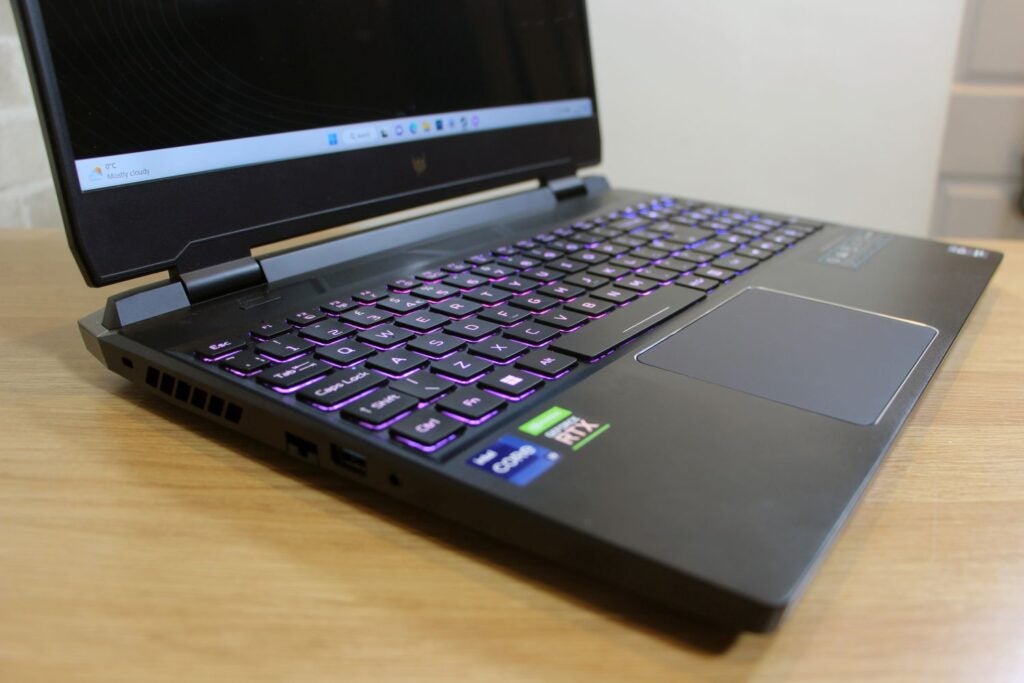
This laptop has a Thunderbolt 4 connection that tackles charging and a USB-C alongside three full-size USB ports. Image output comes from HDMI 2.1 and mini-DisplayPort connections, and internal connectivity is handled by Gigabit Ethernet, dual-band Wi-Fi 6E and Bluetooth 5.2.
That’s good enough for most gamers, but every rival offers more. The Alienware has an extra USB-C connector, SD card reader and Windows Hello webcam, while the MSI deploys an SD card slot, and both 17.3-inch notebooks have 2.5Gbps Ethernet. The convertible Asus accepts microSD cards.
The Predator Helios 300 doesn’t always impress with hands-on time, either. The keyboard has a number pad, per-key lighting and comfortable typing, but it’s soft compared with the crisp, fast units on rivals, which are better for gaming. The trackpad is squishy, and a USB mouse is essential for gamers.
Performance
- Plenty of gaming power, but the RTX 3080 Ti used elsewhere is even quicker
- The i9-12900H is near-unbeaten when it comes to mobile content creation and multi-tasking
- Cool and quiet in standard mode, but don’t bother with the loud high-performance options
The GeForce RTX 3080 may be one of Nvidia’s older laptop GPUs, but it still deploys 8GB of memory and 6144 CUDA cores. Here, it uses its 150W peak power level. The Core i9-12900H is a stonking Intel CPU with six Hyper-Threaded cores and a 5GHz Turbo pace. The 32GB of DDR5 memory is ideal for high-end gaming and content creation.
The main specification rounds out with a 2TB Micron SSD that delivers rock-solid read and write speeds of 6,541Mbps and 4,441Mbps.
In Horizon Zero Dawn at 1080p and top graphics settings, the Predator Helios 300 rocketed through at 102fps. At 4K, its 52fps is easily playable. In Borderlands 3 at 1080p and 4K, it returned averages of 97fps and 41fps.
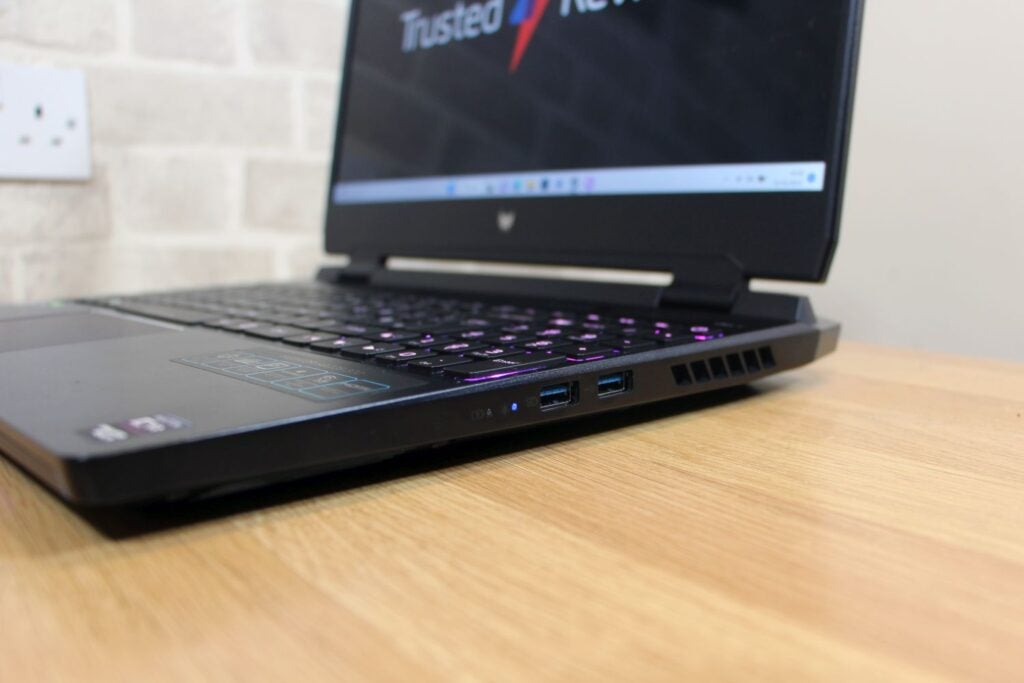
You’ve got plenty of punch if you want to output to eSports-friendly screens too. In Rainbow Six Siege, the Predator Helios 300 averaged 361fps, so 360Hz displays are within reach.
This is great, but the RTX 3080 shows its age. The RTX 3080 Ti in the Alienware zipped through Horizon at 120fps, and the MSI scored 117fps in Borderlands. A peek at 3DMark Time Spy reveals all: the Acer scored 11,976, but the Alienware hit 12,486, and the MSI exceeded 13,500 points.
You’ll also have to take a hit if you want to play with the 3D tech. Forza Horizon 5 ran at 70fps without the stereoscopic tech activated – but at 41fps once it was switched on.
The Predator Helios 300’s performance modes underwhelm. This notebook has Extreme and Turbo modes that add a few frames of speed in games, but they hugely increase the noise output. When its fan noise is modest and manageable in default mode, those performance options don’t seem worth it.
This laptop is good rather than great when it comes to gaming, but it’s more impressive in application tests. The i9-12900H is a powerhouse that scored 1,643 and 13,721 in the Geekbench single and multi-core benchmarks. The latter result streaks ahead of the Core i7 part deployed in the Alienware, and it’s even further ahead of the AMD CPU inside the Asus.
There’s little between the three in PC Mark 10, but that benchmark is more reflective of everyday productivity tasks, and all excel in that department.
| Acer Predator Helios 300 | Alienware x17 R2 | MSI Raider GE77 | |
| CPU | Intel Core i9-12900H | Intel Core i7-12700H | Intel Core i9-12900HX |
| PC Mark 10 | 7268 | 7856 | 7038 |
| Geekbench 5 Single / Multi | 1643/ 13,721 | 1686 / 12,040 | 1833/ 15,872 |
| GPU | Nvidia RTX 3080 | Nvidia RTX 3080 Ti | Nvidia RTX 3080 Ti |
| 3DMark Time Spy | 11,976 | 12,486 | 13,593 |
Those results mean that the Predator Helios 300 is a superb choice for work and play. The i9-12900H will easily handle photo editing, 4K video editing, streaming and multitasking alongside other creative assignments. This laptop also made very little noise when churning through tough work scenarios, and the external panels remained cool.
Only the MSI offers more power, but that’s no surprise from its Core i9-12900HX processor. And don’t turn to the performance modes for more CPU grunt, either, because the Acer’s Turbo option only raised its Geekbench results to 1,672 and 13,934.
The performance discussion is more pertinent when you consider pricing. If you’d like an Alienware with an RTX 3080 Ti and 32GB of memory, then the prices start at $3,349/£3,854/€4,403 and peak around $3,999/£4,000/€4,600 depending on your screen options.
The MSI currently costs $3,799 or €3,799, but its European price of €5,199 is sky-high. The hybrid Asus has a slower RTX 3070 Ti, but it offers relatively good value at $2,699/£2,799/€2,999.
Some of those figures aren’t far away from Predator Helios 300’s $3,499/£3,699/€4,000 pricing, and you’re able to trade the misfiring 3D display for more gaming performance and better design in other areas.
Battery Life
- An hour of gaming and 3hrs of work
- Some rivals offer double the battery life in non-gaming situations
The Predator Helios 300 is a powerful, innovative laptop, but you won’t find anything new when it comes to the battery. It lasted for just over 1hr when gaming and nearly 3 hours in an everyday work benchmark. If you stress the internals with creative workloads, expect 2 hours.
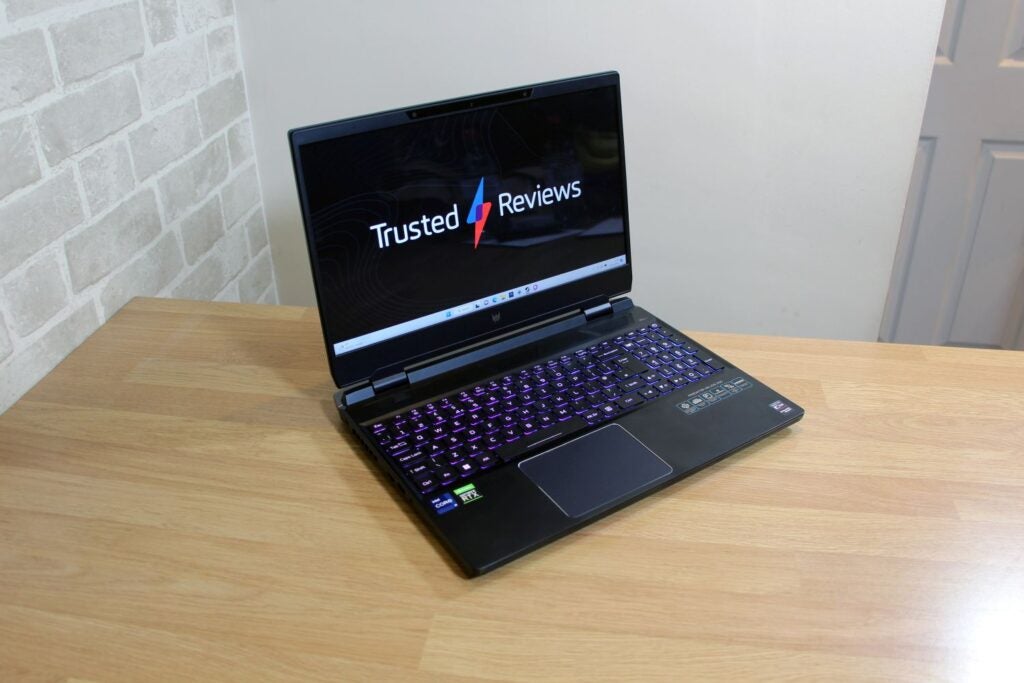
The Predator Helios 300’s best result came in a video test with reduced screen brightness, but its 4 hour lifespan is hardly going to break any records.
Still, it’s not the only high-end gaming laptop to suffer from short battery life: there’s little to choose from between the Helios and the Alienware. The MSI and Asus both returned better results in non-gaming tests, but even then, lifespans plummet when you load your favourite titles.
Latest Deals
Should you buy it?
You want to try 3D gaming and to have sufficient CPU power for tough creative workloads: The 3D screen impresses when it works smoothly, and could well come into its own in the future, while the processor is deeply impressive already.
You want maximum gaming power for eSports alongside a sleeker design: Look elsewhere, and you’ll find the faster RTX 3080 Ti alongside better refresh rates inside lighter and slimmer notebooks.
Final Thoughts
The Acer Predator Helios 300 SpatialLabs Edition takes a risk that doesn’t quite pay off with the misfiring 3D screen. And while its graphics core and processor both offer impressive performance levels, you’ll find better speeds and more finesse elsewhere at similar prices.
How We Test
Every gaming laptop we review goes through a series of uniform checks designed to gauge key aspects including build quality, performance, screen quality and battery life.
These include formal synthetic benchmarks and scripted tests, plus a series of real-world checks, such as how well it runs an AAA game.
We used it as our main laptop for at least a week.
We tested the performance via both benchmark tests and real-world use.
We tested the screen with a colorimeter and real-world use.
FAQs
Yes, you can disable the 3D if you wish.








